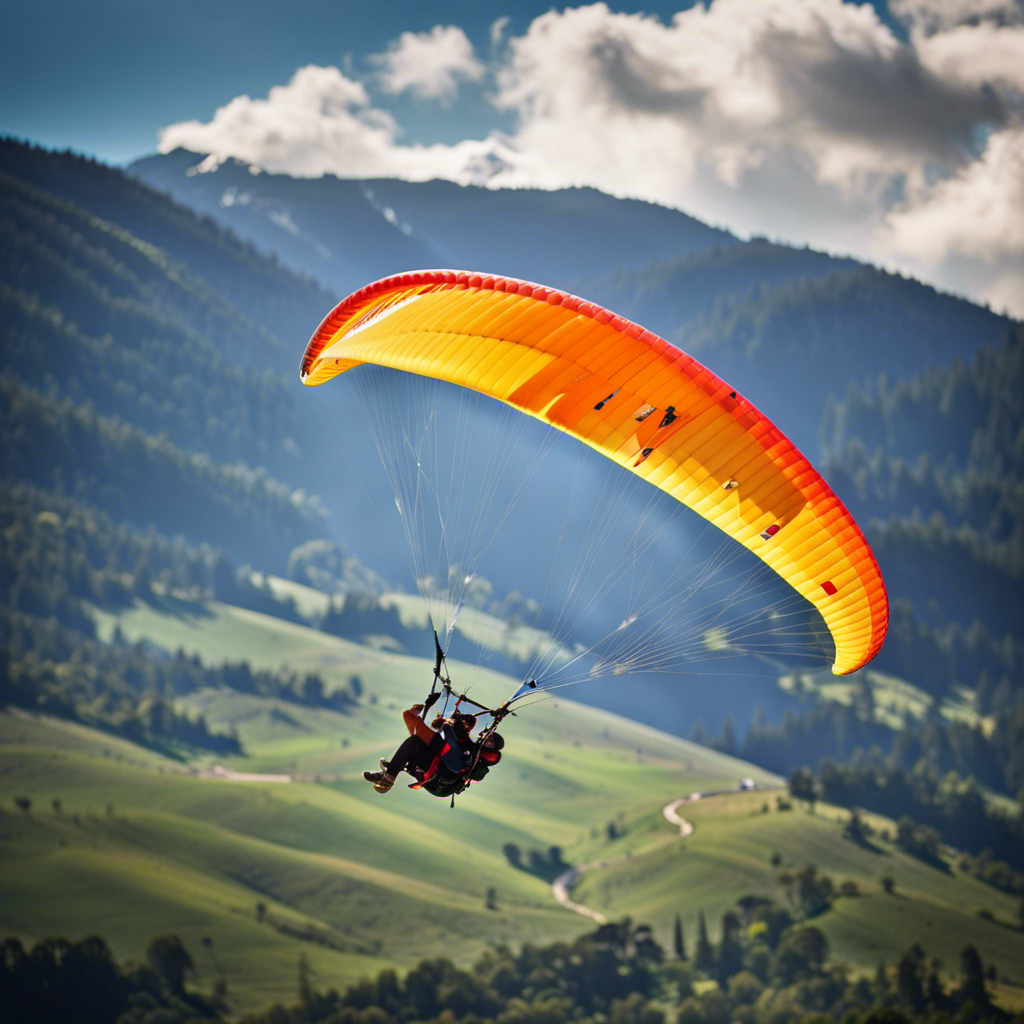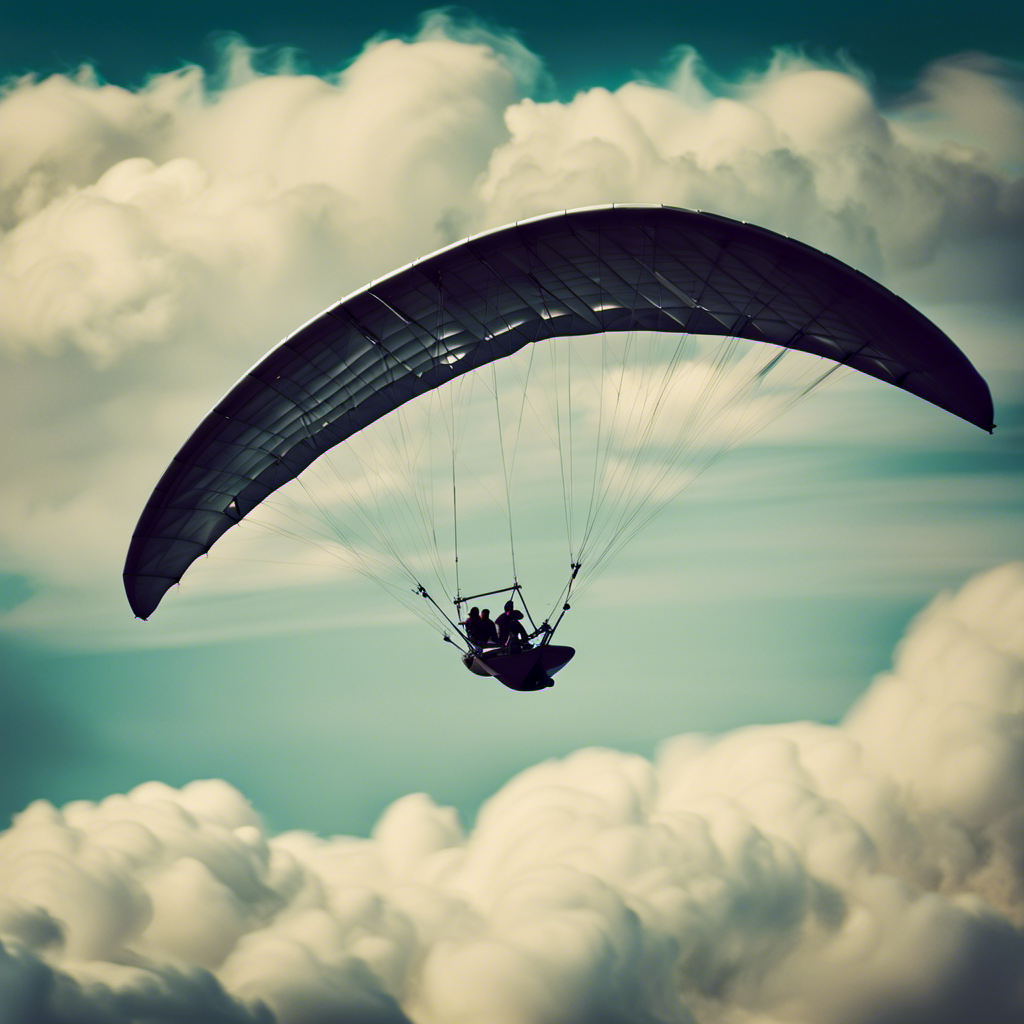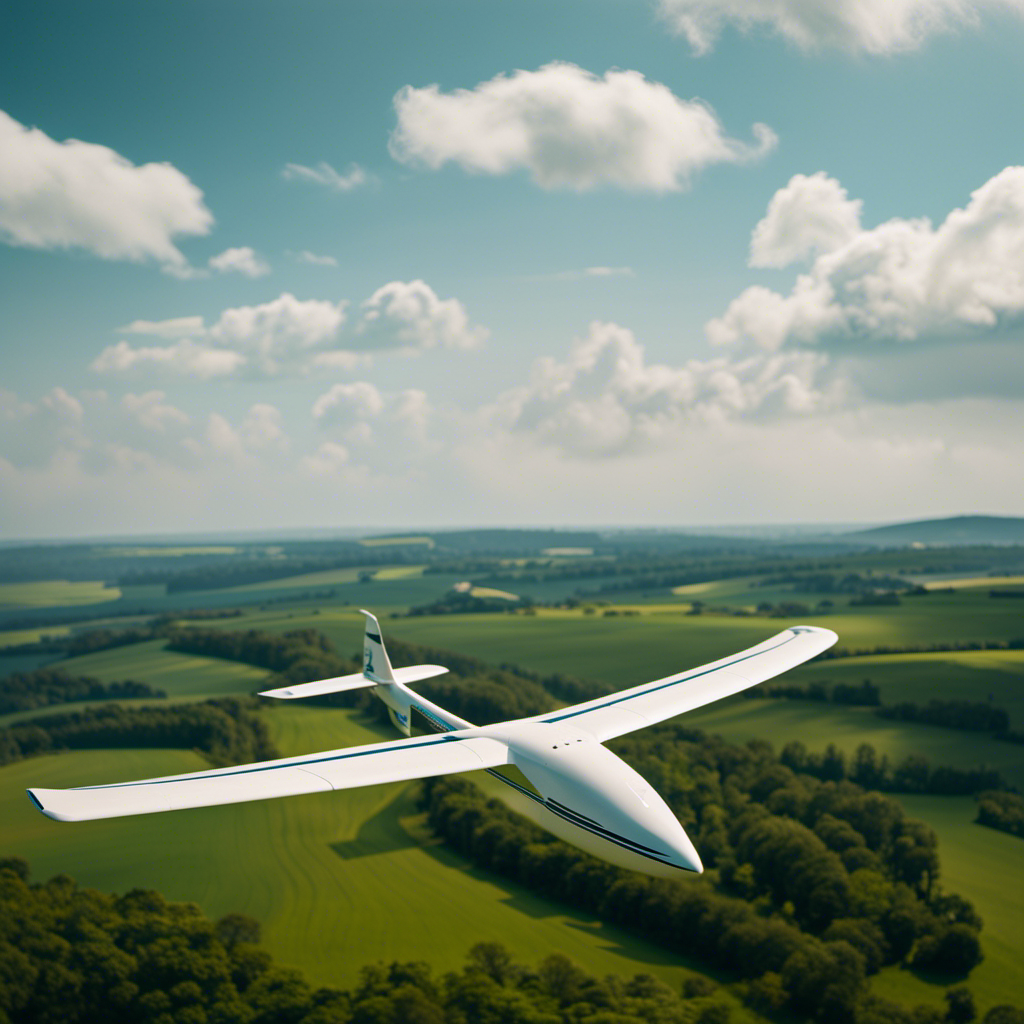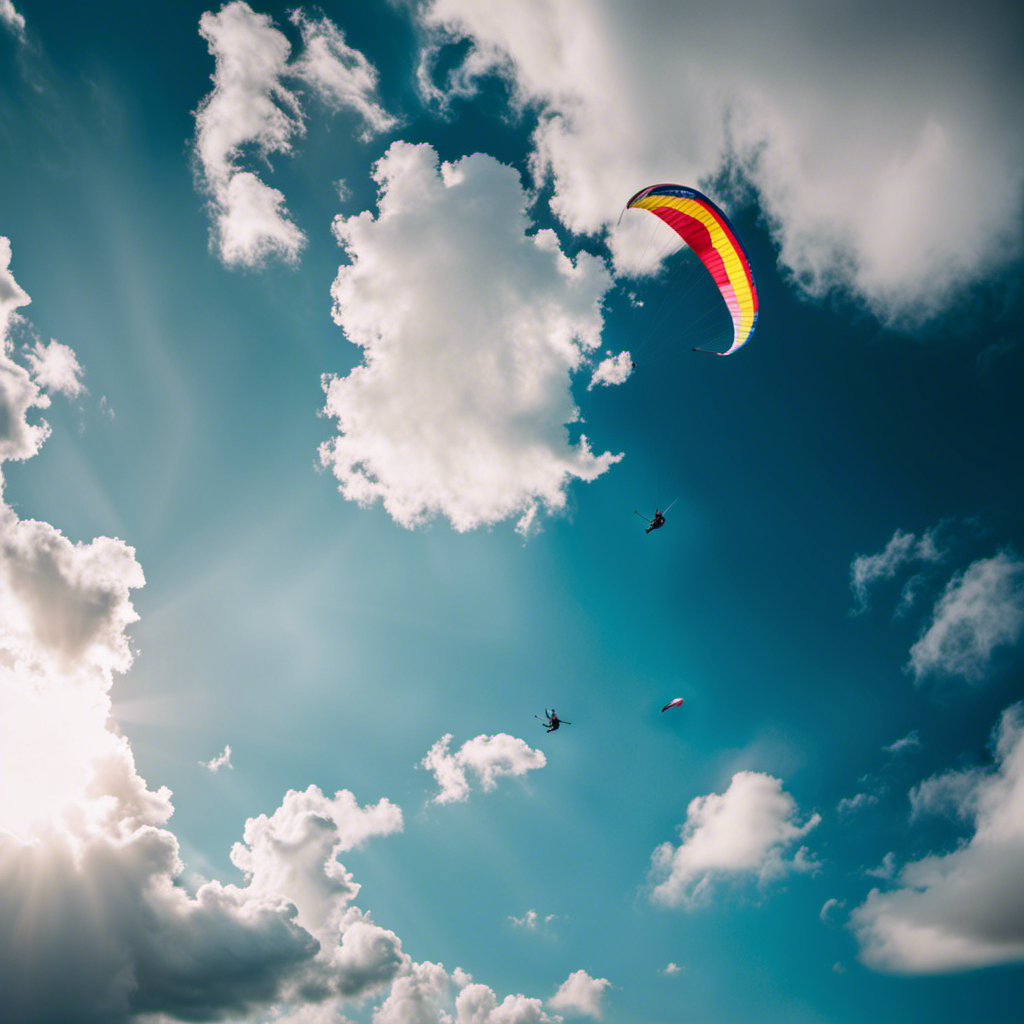Soaring through the sky with just a fabric wing and my sense of adventure, I am constantly amazed by the exhilarating world of paragliding. It combines thrill, skill, and a deep connection with nature’s elements.
If you’ve ever dreamt of mastering the art of paragliding, then you’ve come to the right place. In this article, I’ll share with you the tips and tricks I’ve learned from the experts, so you too can experience the freedom of flying.
Key Takeaways
- Prioritize flight safety at all times
- Develop focus and concentration
- Analyze weather conditions and potential risks
- Practice emergency procedures regularly
Understanding Paragliding Equipment
Understanding paragliding equipment is crucial for those who want to become skilled pilots. As an experienced paraglider, I know the importance of proper gear and maintenance.
When it comes to choosing the right paragliding gear, there are a few key factors to consider. Firstly, make sure the equipment is certified and meets safety standards. Secondly, consider your skill level and flying style to determine the appropriate wing size and design.
Additionally, conducting regular maintenance checks on your gear is essential for safety and optimal performance. This includes inspecting the lines, checking the fabric for any wear or tear, and ensuring the reserve parachute is in good condition.
By understanding paragliding equipment and staying diligent with maintenance, you will be well-prepared to master takeoff and landing techniques seamlessly.
Transitioning into the next section, let’s explore the essential tips for mastering these crucial phases of paragliding.
Mastering Takeoff and Landing Techniques
When it comes to mastering takeoff and landing techniques in paragliding, there are three key points to focus on: proper body positioning, reading wind conditions, and landing with precision.
As an experienced paraglider, I know that maintaining the correct body position during takeoff and landing is crucial for a smooth and controlled flight.
Additionally, being able to accurately read wind conditions allows me to make informed decisions and adjust my approach accordingly.
Proper Body Positioning
To improve your paragliding skills, focus on maintaining proper body positioning throughout your flight. Proper body alignment is crucial for stability and control in the air. Keep your body upright and balanced, with a slight forward lean to optimize your aerodynamics. Engage your core muscles to maintain a stable position and avoid unnecessary movement.
Additionally, mastering weight shifting techniques is essential. By shifting your weight, you can control the direction and speed of your flight. Lean into turns to initiate them smoothly and maintain control.
As you transition into the next section about reading wind conditions, it’s important to understand that proper body positioning is the foundation for effectively reading and responding to the wind’s cues.
Reading Wind Conditions
Reading wind conditions is crucial for maintaining control and making informed decisions during your flight. As an experienced paraglider, I have learned the importance of analyzing wind patterns and adjusting my flight strategy accordingly.
By observing the direction, speed, and turbulence of the wind, I can anticipate how it will affect my flight path and adjust my wing control to maintain stability. This knowledge allows me to make necessary adjustments to my flight plan, such as choosing the best route or altering my altitude.
Understanding wind conditions also helps me avoid potential hazards, such as strong gusts or thermals. By staying vigilant and continuously assessing the wind, I can ensure a smoother and safer flight.
Now, let’s transition to the next section, where we will discuss the art of landing with precision.
Landing with Precision
Landing with precision requires careful control of the wing and precise timing. As an experienced paraglider, I understand the importance of achieving a precise touchdown and landing accuracy. It is a skill that takes practice and attention to detail. To help you understand the key elements of a precise landing, let me break it down for you in a visual representation:
| Key Elements | Importance |
|---|---|
| Wing Control | Essential |
| Timing | Crucial |
| Touchdown | Precise |
By mastering wing control, you can manipulate the glider’s movements to ensure a smooth and controlled descent. Timing is crucial to synchronize your actions with the wind conditions and other factors. Finally, the touchdown must be precise, allowing you to land safely and smoothly.
Now that you understand the importance of landing with precision, let’s move on to developing skills in flight maneuvers, where we will explore the next level of paragliding expertise.
Developing Skills in Flight Maneuvers
Once you’re comfortable with basic paragliding techniques, it’s time to start honing your skills in flight maneuvers. This is where you can really push the limits of what you and your wing can do. Here are some key flight maneuvers to master:
- Wingovers: These are great for gaining altitude and can be a thrilling experience.
- Spirals: A more advanced maneuver that involves descending rapidly in a tight spiral.
- Big ears: Useful for losing altitude quickly and efficiently.
- B-stall: This maneuver helps you control your wing’s speed and can be used for landing.
- Asymmetric collapses: Important to practice for emergency situations.
Flight safety should always be your top priority. Be sure to familiarize yourself with emergency procedures and practice them regularly.
Now that you’ve honed your skills in flight maneuvers, let’s move on to navigating cross-country flights, where we’ll explore techniques for staying on course and maximizing your distance.
Navigating Cross-Country Flights
As you navigate cross-country flights, it’s important to familiarize yourself with techniques for staying on course and maximizing your distance. Weather conditions play a crucial role in determining the success of your flight. Before taking off, carefully analyze the forecast and identify any potential challenges such as strong winds or turbulent air.
During the flight, continuously monitor the weather and adjust your route accordingly. Route planning is another key aspect to consider. Study the terrain, identify landmarks, and plan your waypoints in advance. This will help you stay on track and avoid getting off course.
By combining your knowledge of weather conditions with effective route planning, you can navigate cross-country flights with confidence and precision.
Now, let’s delve into improving thermalling and soaring techniques, which will further enhance your paragliding skills.
Improving Thermalling and Soaring Techniques
Improving your thermalling and soaring techniques can greatly enhance your paragliding skills. When it comes to gliding, it’s all about maximizing lift and staying in the air as long as possible.
One key aspect to improving your gliding skills is to understand the wind patterns and thermal sources in the area. By studying the weather conditions and learning to read the sky, you can identify the areas of strongest lift and position yourself accordingly.
Additionally, honing your turning technique is crucial. By maintaining a tight, coordinated turn in thermals, you can efficiently climb and gain altitude. It’s also important to practice weight shifting and weight control to maintain the correct bank angle and optimize your gliding performance.
By mastering these techniques, you’ll be able to stay in the air longer and cover more distance during your flights.
Enhancing safety and risk management is another key aspect of becoming a proficient paraglider pilot.
Enhancing Safety and Risk Management
Enhancing safety and risk management is crucial for becoming a proficient paraglider pilot. In order to minimize accidents and ensure a safe flight, it is important to constantly improve emergency procedures and evaluate weather conditions.
Being prepared for potential emergencies is essential in this sport, as it involves flying in unpredictable environments. Evaluating weather conditions, such as wind speed and direction, cloud formations, and air stability, allows for better decision-making during flight planning. Additionally, regularly practicing emergency procedures, such as quick landings or managing paraglider collapses, can significantly improve response time and reduce the risk of injury.
By prioritizing safety and risk management, paraglider pilots can enjoy the sport with confidence and peace of mind.
Transitioning into the subsequent section about ‘building mental and physical fitness’, it is important to recognize that safety and risk management go hand in hand with personal well-being.
Building Mental and Physical Fitness
When it comes to paragliding, mental and physical fitness are crucial for a successful and enjoyable experience.
Developing focus and concentration is key to maintaining control and making split-second decisions while in the air.
Building strength and endurance is essential for withstanding the physical demands of long flights and challenging conditions.
Lastly, managing fear and anxiety is vital for staying calm and composed in potentially stressful situations.
Developing Focus and Concentration
To develop focus and concentration while paragliding, it’s important to practice mindfulness techniques.
When I take to the skies, I know that being mentally prepared is just as essential as physical fitness. One effective method is visualization, where I imagine myself navigating the currents effortlessly and smoothly. This helps me stay focused on the task at hand and maintain concentration throughout the flight. By visualizing successful flights, I build confidence and reinforce positive thinking.
Additionally, I practice mindfulness techniques such as deep breathing and staying present in the moment. This allows me to stay fully engaged with my surroundings and react quickly to any changes.
As I transition into the next section about building strength and endurance, I bring this same level of focus and concentration to my physical training.
Building Strength and Endurance
Building strength and endurance is essential for paragliders who want to push their limits and achieve greater heights. As an experienced paraglider, I understand the importance of building stamina and endurance through dedicated training.
Endurance training specifically targets the muscles used during paragliding, such as the core, arms, and legs. Incorporating activities like running, cycling, and weightlifting into your routine can help improve your overall fitness level and endurance. It is important to gradually increase the intensity and duration of your workouts to avoid injuries.
Building strength and endurance not only allows you to fly for longer durations but also enhances your control and maneuverability in the air. By focusing on building your physical capabilities, you can confidently transition into the next section about managing fear and anxiety.
Managing Fear and Anxiety
After building strength and endurance, the next crucial step in mastering paragliding is managing fear and anxiety.
As a seasoned paraglider, I understand that fear can be both a hindrance and a motivator. It is important to acknowledge and respect fear, but not let it control your actions.
One effective technique for managing fear is to break down the process into smaller steps and gradually expose yourself to more challenging flights. Building confidence through small successes will help alleviate anxiety and empower you to take on bigger challenges.
Visualizing successful flights and positive outcomes can also be a powerful tool in managing fear.
By developing strategies to overcome fear and building confidence, you will be better equipped to handle the unpredictable nature of paragliding.
Now, let’s delve into the invaluable lessons we can learn from experienced pilots.
Learning from Experienced Pilots
Learning from experienced pilots is a great way to improve your paragliding skills. When I first started paragliding, I sought out the guidance of seasoned pilots who had years of experience under their belts. They taught me valuable learning techniques and shared their wealth of knowledge, helping me gain experience and confidence in the sport. Sitting down with them and discussing their experiences was incredibly insightful and allowed me to learn from their mistakes and successes. To give you a glimpse of the wisdom I acquired, here’s a table summarizing some key tips and tricks shared by these experts:
| Learning Techniques | Gaining Experience |
|---|---|
| Visualizing successful flights | Flying in different weather conditions |
| Practicing ground handling skills | Participating in cross-country flights |
| Analyzing flight footage | Attending paragliding clinics and workshops |
| Seeking feedback from experienced pilots | Joining a local paragliding club |
| Learning emergency procedures | Building a strong network of fellow pilots |
Exploring Advanced Techniques and Specializations
When it comes to exploring advanced techniques and specializations in paragliding, there are a few key points that come to mind.
First, acrobatic paragliding and SIV training are essential for those wanting to push the boundaries of their flying skills and learn maneuvers such as wingovers, spirals, and stalls.
Second, cross-country competitions and races provide an exhilarating opportunity to test your endurance and strategic planning as you navigate through varying wind conditions and terrain.
Lastly, tandem and acro flying allow experienced pilots to share the joy of paragliding with others while performing thrilling stunts and maneuvers in the air.
Acrobatic Paragliding and SIV Training
To improve your skills in acrobatic paragliding and SIV training, you’ll need to practice maneuvers such as wing overs and SATs. These maneuvers require precise control and coordination, allowing you to push the limits of your paraglider’s performance.
Here are three key maneuvers to master:
-
Wing Overs: By pulling on the brake lines asymmetrically, you can induce a rolling motion in your paraglider. This maneuver creates an exhilarating sensation as you smoothly carve through the air, feeling the G-forces build up.
-
SATs: Short for ‘Spiral Dive with Accelerated Turn,’ SATs involve entering a controlled spiral dive while simultaneously initiating a spin. This maneuver requires a solid understanding of weight shifting and harness control, resulting in an incredible spinning sensation that will leave you breathless.
-
Emergency Procedures: While acrobatic flying is thrilling, it’s crucial to be prepared for any unforeseen circumstances. Make sure you are familiar with emergency procedures, such as how to recover from a spin or execute a reserve parachute deployment.
Now, let’s transition into the next section on cross-country competitions and races, where we’ll explore the exciting world of long-distance paragliding adventures.
Cross-Country Competitions and Races
Now, let’s dive into the exhilarating world of cross-country competitions and races. Here, you’ll have the opportunity to showcase your paragliding skills and compete against other talented pilots.
Cross-country navigation is a crucial skill in these events. It requires you to navigate through varying terrains, using your experience and knowledge to make the best decisions. To succeed, strategic race tactics are essential.
This involves analyzing weather conditions, wind patterns, and thermals to determine the most efficient route. It’s important to choose the right moments to push your speed and conserve energy when needed. By honing these skills, you can improve your chances of reaching the finish line before your competitors.
Now, let’s move on to the next section where we’ll explore the exciting world of tandem and acro flying.
Tandem and Acro Flying
Tandem and acro flying allows you to experience the thrill of paragliding with a partner and perform exhilarating maneuvers in the air. When it comes to tandem flying, safety is paramount. It’s crucial to ensure that both you and your partner are properly equipped with the necessary safety gear, such as helmets and harnesses. Additionally, it’s important to undergo thorough training and follow all safety protocols to minimize any potential risks.
Acro flying, on the other hand, takes paragliding to a whole new level. It involves performing advanced maneuvers like spins, loops, and wingovers. Mastering these maneuvers requires skill, precision, and experience. It’s essential to receive proper training from experienced instructors who can guide you through the process and ensure your safety.
Transitioning from tandem and acro flying to setting and achieving paragliding goals requires discipline and determination. By building on the skills and experience gained from tandem and acro flying, you can set realistic goals and work towards achieving them. Whether it’s improving your flying techniques, participating in competitions, or exploring new and challenging flying sites, the key is to stay focused and dedicated to your paragliding journey.
Setting and Achieving Paragliding Goals
When it comes to achieving success in paragliding, goal-setting and planning are essential.
As an experienced paraglider, I know the importance of setting specific and measurable goals, as well as creating a detailed plan to reach them.
Additionally, tracking progress and celebrating milestones along the way not only provide motivation but also serve as indicators of growth and improvement.
Lastly, pushing boundaries and challenging yourself is crucial for personal and skill development in paragliding, allowing you to reach new heights and overcome obstacles.
Goal-Setting and Planning
Setting achievable goals is crucial in paragliding, as it helps me plan my progression effectively. As an experienced paraglider, I have developed goal setting strategies and effective planning techniques that have greatly enhanced my flying experience. Here are some key strategies I employ:
| Goal Setting Strategies | Effective Planning Techniques |
|---|---|
| 1. Start small and build momentum | 1. Create a detailed timeline |
| 2. Set specific and measurable goals | 2. Break down goals into smaller tasks |
| 3. Prioritize goals based on importance and feasibility | 3. Allocate resources and time efficiently |
Tracking Progress and Celebrating Milestones
By regularly tracking my progress and celebrating milestones, I can stay motivated and continuously improve my paragliding skills.
Tracking progress is crucial in any endeavor, and paragliding is no exception. I make it a habit to record my flights, noting the distance covered, altitude gained, and any challenges faced. This allows me to objectively assess my performance and identify areas for improvement.
Celebrating achievements along the way is equally important. Whether it’s reaching a new altitude milestone or successfully navigating a challenging flight path, acknowledging these milestones boosts my confidence and keeps me motivated to push further.
Pushing Boundaries and Challenging Yourself
Pushing your boundaries and challenging yourself in paragliding is a surefire way to grow as a pilot and experience new levels of exhilaration. As an experienced pilot, I can attest to the transformative power of pushing your limits in this sport.
When you step out of your comfort zone and venture into unfamiliar territory, you not only expand your skills but also discover new strengths within yourself. It’s in those moments of pushing your limits that personal growth happens.
Each time you challenge yourself and overcome obstacles, you become more confident and capable as a paraglider. So, don’t be afraid to take risks, try new maneuvers, and explore different flying conditions.
Embrace the thrill of pushing your boundaries, and watch as you soar to new heights both on and off the paragliding field.
Frequently Asked Questions
What are the common injuries associated with paragliding and how can they be prevented?
To prevent common paragliding injuries, it is important to take safety precautions when flying at night or in low light conditions. This includes using proper lighting equipment, maintaining situational awareness, and ensuring visibility to other pilots.
How can I improve my decision-making skills during flight to ensure a safe and successful experience?
Improving decision making is crucial for enhancing safety. Like a compass guiding my path, I learned to trust my instincts and analyze weather conditions, terrain, and my own abilities. This ensures a successful and secure paragliding experience.
Are there any specific weather conditions that I should be cautious of when planning a cross-country flight?
When planning a cross-country flight, it’s crucial to be cautious of certain weather conditions. Unfavorable conditions like strong winds, thunderstorms, or low visibility can pose significant risks and should be avoided to ensure a safe and successful flight.
What are some strategies for dealing with fear and anxiety while paragliding?
Overcoming fear and managing anxiety while paragliding requires a combination of mental and physical strategies. Deep breathing, positive self-talk, and visualization techniques help calm the mind, while proper training and equipment ensure safety.
Is it possible to paraglide at night or in low-light conditions, and what additional safety precautions should be taken?
Yes, it is possible to paraglide at night or in low-light conditions. However, additional safety precautions must be taken, such as using proper lighting and reflective gear. It is important to have good decision-making skills, be aware of weather conditions for cross country flight, and use strategies for dealing with fear and anxiety to minimize paragliding injuries.
Conclusion
In conclusion, mastering paragliding is a journey that requires dedication, perseverance, and a thirst for knowledge.
It is a sport that combines the thrill of flight with the beauty of nature, and the satisfaction of pushing oneself to new heights.
Just like a bird soaring through the sky, paragliding allows us to experience a freedom and sense of adventure that is truly unparalleled.
By following the tips and tricks shared by the experts, we can strive to become the best pilots we can be and reach new horizons in the world of paragliding.
So spread your wings, embrace the wind, and let your dreams take flight.
With a heart that soars as high as the skies, Aria, affectionately known as “Skylark,” is the driving force behind Soaring Skyways. Her journey into the gliding world began as a young dreamer gazing up at the soaring birds, yearning to experience the weightlessness and freedom they embodied. With years of experience both in the cockpit and behind the scenes, Aria’s commitment to the gliding community is unwavering.










